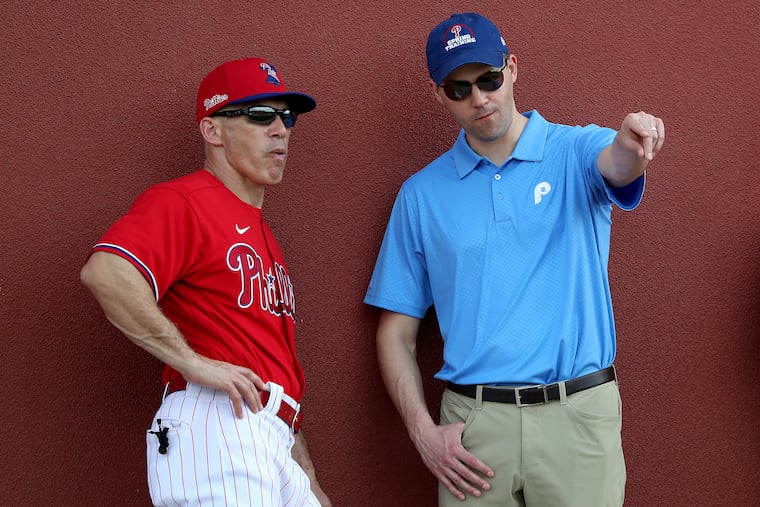Tough regional schedule might be ‘reality check’ for Phillies’ playoff ambitions | Scott Lauber
Four months ago, general manager Matt Klentak called the NL East "the most competitive division in baseball." Two-thirds of the Phillies' games in the coronavirus-shortened season will be played against the NL East.

Four months and another world ago, when the Phillies gathered in Florida for what appeared to be a placid spring training, team officials had one overriding concern: the National League East.
It’s the case before any season that the Phillies would gauge their chances of success by sizing up their rivals. But after hiring an accomplished manager (Joe Girardi) and adding a talented free-agent pitcher (Zack Wheeler) and a shortstop (Didi Gregorius) to a group that won 81 games last year, the club’s high command wondered -- sometimes aloud, often privately -- if the roster was good enough to win, say, the NL Central but still finish fourth in the loaded NL East.
“I think we’re realistic about the division,” general manager Matt Klentak said Feb. 13. “The National League East is about -- if not the toughest division -- the most competitive division in baseball. We have four teams that are going for it, and you don’t often find that in any division. So there’s a little bit of a reality check about the competition level this year.”
What, then, might Klentak call a season that will be played -- if, in fact, it can be played with the air still so thick with coronavirus -- predominantly against the NL East, with a few games tossed in against the historically tough American League East?
Unyielding? Punishing?
How about “savage,” the adjective that the New York Yankees -- the Phillies’ new interleague foe -- chose to describe themselves last year en route to 103 wins ... and that was before they signed Gerrit Cole, the best pitcher in baseball?
Any day now, Major League Baseball will release the commissioner-imposed 60-game schedule for this pandemic-shortened season. To minimize travel in the midst of the coronavirus, teams will stay within their geographically defined region, playing 40 games against division rivals and the remaining 20 against the corresponding division in the other league.
For the Phillies, that means 10 games apiece -- or half of the schedule -- against the World Series-champion Washington Nationals, two-time defending NL East-champion Atlanta Braves, and talent-rich New York Mets. In an ordinary 162-game season, those teams would comprise 35% of the Phillies’ schedule.
Depending on how the interleague portion of the schedule is divided, the Phillies could play as many as 12 games -- 20% of the season -- against the Yankees, Tampa Bay Rays, and Boston Red Sox. The pitching-rich Rays won 96 games last season; the Red Sox, a shell of their 2018 World Series-winning team but hardly pushovers, 84.
Mercy.
Moreover, in rejecting MLB’s 60-game proposal this week and forcing Manfred to exercise his authority under the March 26 labor agreement to impose this 60-game slate, the Players Association also blocked the 16-team expanded playoff format that was strongly desired by the owners. Instead, the postseason will be contested by 10 teams, five from each league, just as it has since 2013.
So if the Phillies are going to snap their eight-year playoff drought, they must either win the NL East or capture one of two wild-card spots while playing two-thirds of their games against teams that they went 36-40 against last season.
The path to the latter surely appears to be easier in an NL/AL Central or NL/AL West schedule.
It’s true that every division has its cupcakes. The Phillies will have the opportunity to feast on the putrid Miami Marlins and Baltimore Orioles. But the NL Central is flatter at the top (St. Louis won the division last year with 91 wins, while Milwaukee and the Cubs had 89 and 84 wins, respectively) and gets a steady dose of divisional pushover Pittsburgh and AL Central doormats Kansas City and Detroit, losers of 103 and 114 games in 2019.
According to Baseball Prospectus’ annual PECOTA projections, which were released in February, NL/AL East teams were pegged for a total of 814.6 wins, 13 more than the NL/AL Central (801.3) and slightly edging the NL/AL West (814.2).
Sixty games -- baseball’s shortest season since 1878 and 37% of a normal year -- would seem to create the opportunity for fluke outcomes, with some of the best teams being left out of the playoffs in favor of lesser clubs that catch fire.
Using the “streak analyzer” feature at Baseball-Reference.com, it’s possible to see how teams fared over finite stretches of any season. Looking at teams’ records from the first 60 games of each season since 2013, 72.5% of clubs that reached the playoffs (58 of 80) still would have qualified if the season ended after 60 games. But the last two NL champions -- the 2019 Nationals and 2018 Los Angeles Dodgers -- would have been omitted.
The worst team that would have made it: the 2017 Baltimore Orioles, 31-29 through 60 games, 75-87 after 162. Five of the 22 teams that were in playoff position after 60 games and ultimately missed the playoffs finished below .500 for the season.
Worth noting: At 33-27, the 2019 Phillies were a wild-card team after 60 games. They went 48-54 the rest of the way and finished with the NL’s ninth-best record.
And they had the luxury of playing against more than merely their unforgiving division.